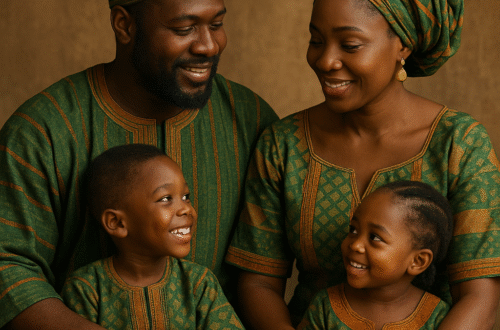
“The Devil’s Tool”: Postcolonial Misogynoir and the Symbolic Undoing of African Women in Conclave
Abstract
This paper critically examines Edward Berger’s Conclave (2024) through the prism of postcolonial feminist film theory, focusing on the subtle but deliberate vilification and racialization of African women. Drawing on the legacies of cinematic colonialism, the study contextualizes the figure of Ṣàáánúmi within a broader tradition of Western visual culture that commodifies, demonizes, and instrumentalizes the Black female body as an agent of moral collapse and sociopolitical regression. Through a critical discourse analysis that interweaves film aesthetics, race, gender politics, and historical representations, this article reveals how Conclave rehearses old imperial scripts under the guise of ecclesiastical intrigue, effectively repackaging misogynoir in religious robes.
Introduction: Colonial Hangovers in Contemporary Cinema
The cinematic representation of Black subjects, particularly Africans, in Western cinema remains both fertile and fraught. From D. W. Griffith’s The Birth of a Nation (1915) to Edward Berger’s Conclave, Western film has historically served as a conduit for cultural hegemony. Such representations reinforce visual stereotypes that situate Africans within a deficit narrative, portraying them as morally suspect, culturally backward, and intellectually inferior. As Shohat and Stam argue, Eurocentric cinematic regimes often naturalize white superiority through representational codes that persistently distort the African reality. This framing is not incidental but is tethered to the history of empire and its cinematic legacies. From its inception, cinema was a tool of empire, used to narrate the civilizational project of colonialism and legitimize imperial domination. The cinematic apparatus naturalized colonial hierarchies by embedding them in visual codes—white as orderly and rational, black as chaotic and primitive. In this regard, Conclave is merely the latest iteration of a long-standing visual tradition, repacking old ideological formations in new narrative clothes. The persistence of these codes in the twenty-first century underscores the durability of colonial aesthetics and the necessity of postcolonial critique. The black body, especially the black female body, is weaponized to reinforce dominant narratives of savagery and moral failure (hooks, 1992; Mulvey, 1975).
The trope of the treacherous African woman is not a novel cinematic device but rather a deeply entrenched representational pattern. As Amadiume (1997) and Oyěwùmí (1997) have shown, colonial discourse frequently constructed African womanhood in oppositional terms to European civility and chastity. In Conclave, Ṣàáánúmi is configured as a relic of Cardinal Adeyemi’s carnal past, invoking the Jezebel archetype, which reinforces the notion that African femininity is inherently destructive. This aligns with broader patterns in Western media where Black women are either hypersexualized or completely desexualized, always at the service of white or patriarchal projections (Collins, 2000). Rather than a fully realized character, she becomes a repository for guilt, shame, and betrayal—functions consistent with the stereotypes explored by bell hooks and Patricia Hill Collins. The Yoruba proverb, “Obìnrin lèké…,” is weaponized to reaffirm the suspicion and disposability historically assigned to Black women. This trope is not only reductive but violently effaces the complexity of African womanhood. Ṣàáánúmi’s character is presented without interiority—her motivations, desires, or beliefs are never explored. Her narrative function is to seduce, to betray, and ultimately to disappear, fulfilling the Western cinematic fantasy of the expendable Black woman. Such portrayals echo the historical use of Black women as cautionary figures in religious and moral instruction, warning against the perils of desire and the fallibility of Black men when seduced by their own kin. It is also worth noting that such cinematic positioning reifies white femininity as pure and redemptive while portraying Black femininity as deviant and destructive.
Ṣàáánúmi as Symbol: Names, Narrative, and the Inversion of Mercy
Names in African cultures are laden with meaning, often indicative of a person’s destiny or communal values (Mbiti, 1969). Thus, African names are not merely identifiers; they encode spiritual, social, and cosmological significations. Ṣàáánúmi, meaning ‘Show me mercy,’ is recontextualized in the film as a figure of condemnation rather than clemency. This inversion exemplifies Spivak’s concept of epistemic violence, wherein subaltern subjects are stripped of the right to signify on their own terms. The name becomes an ironic cipher of guilt, twisting Yoruba cultural idioms into tools of degradation. Names in Yoruba cosmology are not arbitrary; they are spiritual declarations. To name a child Ṣàáánúmi is to invoke divine compassion and spiritual clarity. Thus, the film’s cynical inversion of this name operates as a desecration of indigenous semiotics. Such inversion also contributes to a broader narrative strategy that devalues African epistemologies. Ṣàáánúmi is denied agency even in her naming—a symbolic erasure of voice and personhood. Her character thus becomes a silent indictment of African traditions, implicitly framing Yoruba values as incompatible with Christian virtue or ecclesiastical dignity. This misrepresentation participates in the ongoing symbolic annihilation of African women in global media (Tuchman, 1978).
Berger’s narrative relies heavily on a familiar racial trope: the intra-racial betrayer. Ṣàáánúmi’s deployment by Cardinal Tremblay redirects accountability away from the Church’s corrupt hierarchy and onto African intimacy. This narrative mechanism mirrors Fanon’s analysis of colonial guilt, whereby the colonized subject internalizes blame and assumes the burden of moral failure. Such framing reinforces Western paternalism and the myth that African leadership is inherently flawed and self-destructive. This trope has deeper roots in the plantation economy, where Black collaborators were often used to suppress revolts or spy on fellow enslaved persons. Its reappearance in modern cinema suggests an unresolved cultural trauma. Ṣàáánúmi’s betrayal of Adeyemi functions as a contemporary plantation drama, wherein proximity to whiteness is rewarded and Black solidarity is punished. This also speaks to the colonial ideology of divide and rule, now performed through cinematic narrative. Moreover, by placing the burden of disclosure on Ṣàáánúmi rather than the structural hypocrisy of the Church, the film absolves the institution of its own sins, transferring moral weight onto the marginalized. This narrative device aligns with what Bhabha (1994) describes as the mimicry of colonial subjects, used here as a strategic betrayal to absolve white characters of complicity. This black-on-black betrayal trope absolves systemic racism by focusing on intra-racial transgression, which, as Fanon (1967) warns, turns the oppressed against themselves. The politics of respectability—where Black success is always contingent on personal moral perfection—are thus employed to delegitimize Adeyemi’s papal candidacy while leaving the broader ecclesiastical corruption untouched.
Aesthetics of Innocence and Culpability: Visual Codes and Cinematic Framing
Through mise-en-scène, lighting, and shot composition, Conclave constructs Adeyemi as a Christ-like figure while rendering Ṣàáánúmi exotic and ominous. This visual coding participates in a colonial cinematic tradition where Blackness is overdetermined by excess and transgression. Mulvey’s ‘male gaze’ is extended here to a racialized colonial gaze that aestheticizes Black women only to delegitimize their moral authority. The visual economy of Conclave operates through oppositional binaries: dark versus light, silence versus confession, devotion versus desire. Ṣàáánúmi is frequently framed through tight, claustrophobic shots that emphasize her isolation and ambiguity. Her modest yet evocative costuming obscures rather than clarifies her role, forcing viewers to project their own assumptions. In contrast, Adeyemi is consistently afforded soft lighting and expansive camera angles that humanize his fall from grace. These visual choices are not neutral; they are ideological, reinforcing who deserves empathy and who is marked for judgment. Such framing mirrors colonial ethnography, where the camera served as both observer and judge. The visual framing of Ṣàáánúmi and Cardinal Adeyemi underscores their moral positions within the film. Berger utilizes cinematic codes to elicit viewer empathy for Adeyemi while presenting Ṣàáánúmi through a lens of suspicion. Her introduction in dim lighting and minimalist dialogue aligns with Mulvey’s (1975) ‘to-be-looked-at-ness’, but through a colonial filter. Her body is both fetishized and vilified, a visual repository for sin and seduction. Meanwhile, Adeyemi is presented through sacrificial imagery—kneeling, weeping, and cloaked in liturgical garb—enhancing his martyrdom. This binary reflects how Western cinema manipulates visual aesthetics to construct hierarchies of innocence and culpability (Stam, 2000).
The term misogynoir, coined by Moya Bailey (2010), aptly describes the intersection of anti-Blackness and misogyny in Ṣàáánúmi’s portrayal. Her character serves neither the narrative nor her own development; she exists solely to trigger the downfall of the Black male protagonist. Such symbolic disposability reflects a deeper cultural anxiety within the Afro-Catholic imaginary. As Tamale (2020) argues, religious institutions have historically cast Black femininity as antithetical to sanctity. Historical scripts of religious misogynoir overdetermine Ṣàáánúmi’s presence in the film. Rather than being a vessel of grace or autonomy, she is rendered a narrative liability, existing solely to undo a Black man’s aspirations. This reflects Bailey’s framework of misogynoir, revealing how Black women are uniquely vilified at the crossroads of race and gender. Berger’s Afro-Catholic imaginary thus becomes a tool of cultural surveillance rather than inclusion, policing who belongs in sacred, global institutions. The film’s treatment of the Catholic Church as a racially neutral institution is deeply flawed. Historically, the Catholic Church has been complicit in both colonial conquest and the racialization of spiritual authority. By positioning Adeyemi’s ambition as naive or overreaching, and Ṣàáánúmi’s intervention as fatal, the film reinforces a theology of exclusion. African religiosity is depicted as either folkloric or fanatical, never as sophisticated or theologically rigorous. Ṣàáánúmi’s role thus becomes doubly marginal—she is both the racial Other and the gendered Other. Her rejection signifies the limits of inclusion within Western religious modernity. The Afro-Catholic imaginary remains a dream deferred, marred by the ghosts of conquest and the stain of sacrificial Black womanhood.
Conclusion: Toward a Decolonial Feminist Reading of African Women in Global Cinema
Despite its aesthetic and narrative sophistication, Conclave remains anchored in colonial mythologies. It reduces Ṣàáánúmi to a plot device—a moral snare deployed against the first viable African pope. Such portrayals demand a decolonial feminist response that recognizes African women not as allegories of failure but as historical and spiritual agents. To move forward, African and diasporic scholars must reclaim cinematic discourse, reshaping the lens through which African womanhood is portrayed. The call for a decolonial feminist reading is not simply a theoretical exercise but an ethical imperative. African women have long borne the brunt of visual and narrative violence in Western media. Their stories are appropriated, misrepresented, or altogether silenced. To reclaim these narratives is to affirm the sovereignty of African subjectivity. Future cinematic projects must move beyond tokenistic inclusion and toward genuine representational justice, rooted in cultural authenticity, narrative depth, and political accountability. This requires an intergenerational, interdisciplinary alliance between African filmmakers, critics, and audiences. Only then can the screen become a space of liberation rather than incarceration.
Works Cited
Amadiume, Ifi. Re-inventing Africa: Matriarchy, Religion and Culture. Zed Books, 1997.
Bailey, Moya. “They Aren’t Talking About Me.” Crunk Feminist Collective, 2010.
Bhabha, Homi K. The Location of Culture. Routledge, 1994.
Collins, Patricia Hill. Black Feminist Thought. Routledge, 2000.
Fanon, Frantz. Black Skin, White Masks. Grove Press, 1967.
hooks, bell. Black Looks: Race and Representation. South End Press, 1992.
Loomba, Ania. Colonialism/Postcolonialism. Routledge, 2005.
Mbembe, Achille. On the Postcolony. University of California Press, 2001.
Mbiti, John S. African Religions and Philosophy. Heinemann, 1969.
Mulvey, Laura. “Visual Pleasure and Narrative Cinema.” Screen, vol. 16, no. 3, 1975, pp. 6–18.
Oyěwùmí, Oyèrónkẹ́. The Invention of Women. University of Minnesota Press, 1997.
Shohat, Ella, and Robert Stam. Unthinking Eurocentrism: Multiculturalism and the Media. Routledge, 1994.
Spivak, Gayatri Chakravorty. “Can the Subaltern Speak?” In Marxism and the Interpretation of Culture, 1988.
Tamale, Sylvia. Decolonization and Afro-Feminism. Daraja Press, 2020.
Trinh, T. Minh-ha. Woman, Native, Other. Indiana University Press, 1989.



